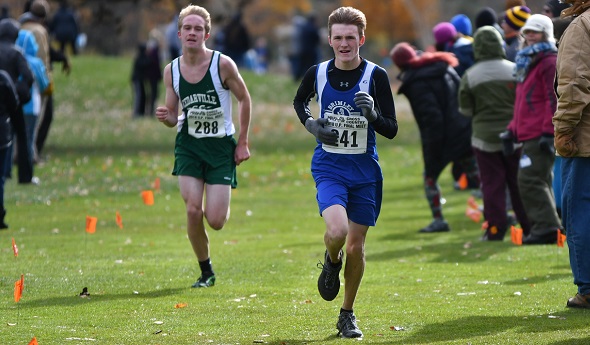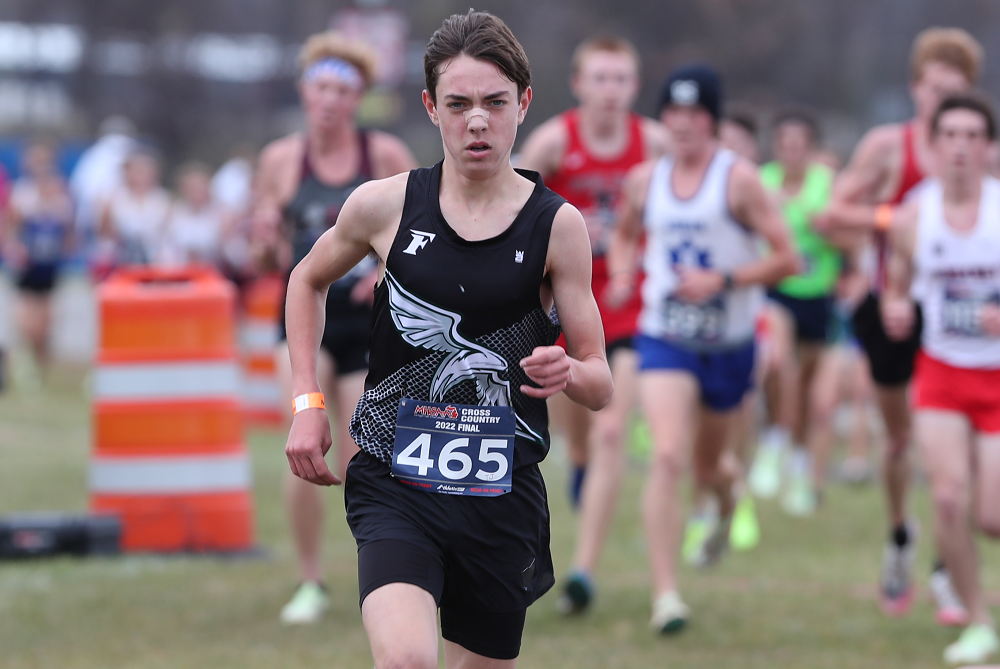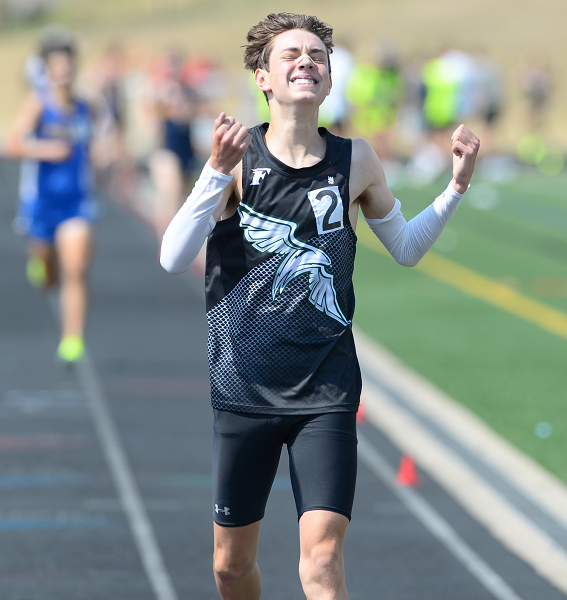
Preview: Historic Finish Guaranteed
October 18, 2019
By Geoff Kimmerly
Second Half editor
Only 16 runners in MHSAA boys cross country history have won three Finals championships. Only one – Central Lake’s Ryan Shay from 1993-96 – finished first four times during his high school career.
Brimley’s Austin Plotkin is part of that three-timers group. By the end of this weekend, he could join Shay is much smaller company.
Upper Peninsula Cross Country Finals races begin Saturday at Gentz’s Golf Course in Marquette with the Division 1 girls at 11 a.m. and finish with the Division 3 boys at 1:30 p.m. Check back Saturday evening for coverage, and see below for more teams and individuals to watch. (Click for race information and competitors.)
Division 1
Reigning champion: Sault Ste. Marie
2018 runner-up: Houghton
Top-ranked: 1. Marquette, 2. Sault Ste. Marie, 3. Houghton.
The Division 1 race has seen plenty of variety lately with four schools winning at least one championship over the last five seasons. The rankings would indicate Marquette as the favorite to jump up from fourth last season and win its first Finals title since 2014. Four of the team’s seven runners from last year are back and all four finished among the top 30 overall, led by now-seniors Hogan Nemetz (13th) and Moses Waide (16th). But Sault Ste. Marie will be right there again with four of the top 14 finishers back – senior Kaaleb Ranta (fourth), junior Jaron Wyma (sixth), senior Zachary Wilcox (eighth) and sophomore Riley Eavou (14th). And reigning individual runner-up Joe Wood is back for his final high school race to lead the reigning team runner-up Houghton, which also has juniors Branden Peterson (11th) and Jake Sullivan (20th) back among others.
Individuals: Gladstone graduated champion Adam Bruce and third-place Jake Strasler. But sophomore Giovanni Mathews could lead the way after finishing fifth a year ago. Total, six of last year’s top 10 are back for this weekend, and Menominee junior Hunter Shepeck is another likely contender after coming in 12th in 2018.
Division 2
Reigning champion: Ishpeming
2018 runner-up: Wakefield-Marenisco/Bessemer
Top-ranked: 1. Ishpeming, 2. Ironwood, 3. Wakefield-Marenisco/Bessemer.
Ishpeming is running for its second straight championship and fifth in six seasons – and finished runner-up in 2017 when Wakefield-Marenisco/Bessemer won the title. W-M/B was runner-up for the other three of the last four championships. Last year’s matchup between the two was decided by 15 points, and Ishpeming returns four top-13 finishers: senior Jonah Broberg (fourth), junior Jordan Longtine (fifth), junior Joseph King (12th) and junior Silas Broberg (13th). Ironwood is expected to maneuver into the second spot this time and brings back junior Blaze Hollenbeck (ninth) and senior David Collins (16th).
Individuals: Senior Adam Mazurek leads the way for Wakefield-Marenisco/Bessemer coming off a seventh place last season. Manistique senior Alex Misniakiewicz also is back after coming in sixth. Total five of the top 10 from last year will return, a number made smaller with Newberry running in Division 3 this fall.
Division 3
Reigning champion: Chassell
2018 runner-up: Brimley
Top-ranked: 1. Chassell, Rock Mid Peninsula, 3. Brimley.
Similar to Ishpeming in Division 2, Chassell also is running for its second straight title and fifth in six seasons, and finished runner-up in 2017 when Brimley came in first. Chassell edged the Bays by 13 points last year and brings back sophomore Daba Holmes (eighth) and junior Kolson Kytta (12th) from a group of five top-13 finishers. Brimley should make a run at the title based on its star power at the top – Plotkin again is the reigning individual champion and junior Cameron Hoornstra finished third last season.
Individuals: Division 3 definitely features the strongest individual race, at least on paper. Cedarville senior Thomas Bohn finished second to Plotkin the last two seasons. Total seven of last year’s top 10 are back, including also Dollar Bay junior Davin Hill (fifth), Rudyard junior Hayden Mills (sixth) and Ewen-Trout Creek sophomore Nik Thomas (10th). Newberry junior Ephram Evans should join the pack after finishing eighth in Division 2 in 2018.
PHOTO: For the second straight Finals last fall, Brimley’s Austin Plotkin just outpaced Cedarville’s Thomas Bohn to win the Division 3 championship. (Photo by Cara Kamps.)

Freeland's Hansen Not Focused on Joining All-Time Greats - But On His Way
By
Paul Costanzo
Special for MHSAA.com
September 29, 2023
The goal written on Matt Kaczor’s Post-It Note was sub-15 minutes, 15 seconds. That’s what the Freeland cross country coach was hoping for from star runner TJ Hansen during his junior season.
 Kaczor tore it up after seeing Hansen run a single race this fall.
Kaczor tore it up after seeing Hansen run a single race this fall.
“Knowing what he did over the summer and where he was at, seeing what his 1,600 (meter) and his mile got down to, I had a feeling he could get under 15:30 quickly,” Kaczor said. “After the first race, I looked at my assistant and was like, ‘I’ve gotta rip up that Post-It Note. I don’t think our goal is on the level of where he’s at right now.’ At first, it was break 15:15. Once I saw him race at the Under the Lights (on Aug. 18 at St. Johns), I was like, ‘Yeah, he’s going sub 15.’”
Hansen ran 15:39.6 in that first race, and on Sept. 7, in Shepherd, he ran 15:13.9 to meet the goal written on the now-shredded Post-It Note.
This past Saturday, he ran 15:03.7 at the Cadillac Veterans Serving Veterans Invitational. It’s the fastest time recorded in Michigan this year, and a signal that Kaczor might be filling out a new Post-It Note before the season is out.
“The sub-15 barrier, that’s been something on my mind for a while,” Hansen said. “Now that I’m edging closer and closer to that, it’s been exciting. With how heavy my training has been, I wouldn’t expect (to have run this fast this early). Being able to run the times I am really paints the picture for what’s ahead.”
Hansen came into the season already regarded as one of the elite distance runners in the state. He won the 3,200 meters at the MHSAA Lower Peninsula Division 2 Track & Field Finals this past spring. He’s also finished all-state (12th and fifth, respectively) the past two seasons at the LPD2 Cross Country Finals.
His current trajectory, however, would put his name near some of the state’s all-time greats. But that’s not something Hansen is focusing on.
“I really don’t like to compare myself to others,” he said. “I don’t focus on that. I try to be the best TJ Hansen that I can be. The best version of myself.”
Focusing on himself is almost necessary for Hansen, as he’s spending a lot of time during his races running by himself.
At each of the big events Freeland has run in this season, Hansen has finished at least 20 seconds ahead of his nearest competitor. That includes all divisions of the Duane Raffin Festival of Races in Holly.
In Cadillac, where Hansen ran his current best time, he was a full minute ahead of the rest of the field.
 “He’s just a special athlete,” Kaczor said. “I can’t see Freeland having someone like this in a while. He’s a generational talent. What’s crazy is, I had the school record when he was a freshman. He and Braden (Honsinger) broke it last year. But TJ has now dropped that school record (set in 1998) by almost a minute.”
“He’s just a special athlete,” Kaczor said. “I can’t see Freeland having someone like this in a while. He’s a generational talent. What’s crazy is, I had the school record when he was a freshman. He and Braden (Honsinger) broke it last year. But TJ has now dropped that school record (set in 1998) by almost a minute.”
Hansen’s achievements have already put him on a path to run at the next level, which is something of a family tradition.
His older sisters Peyton and Kiera are track & field athletes at Wayne State and Eastern Michigan, respectively. Their parents, Tim and Pam, were track & field stars at Central Michigan.
TJ has drawn the attention of coaches around the country, including from Michigan, Michigan State, Wisconsin, Tennessee and Colorado.
Having family members who know the process is a help for Hansen, and he said they’ve all been good about allowing him to choose his own path, whatever that may be.
“He’s from a good family that knows how to work and knows how to get things done,” Kaczor said. “He knows that if he puts in the work, he’s going to be at a good spot.”
While Hansen admits it can be a bit overwhelming, he’s using it as motivation to run faster and continue to put his name out there.
Also serving as motivation is 2022 Division 2 champion Connell Alford of Chelsea. Alford is among the elite group of runners in Michigan who have broken the 15-minute mark, doing it twice a year ago.
He currently has the state’s second-best time behind Hansen’s this year, running 15:09.1 at the MSU Invitational on Sept. 15.
“Whenever I see him drop a time, my main goal is to run faster,” Hansen said. “Whenever I see him run a good time, that motivates me to work hard.”
The two won’t see each other until the MHSAA Finals on Nov. 4 at Michigan International Speedway. It’s an opportunity Hansen is excited for, as it’s a chance to race and be pushed toward the lofty goals he’s set for himself. Kaczor is excited about it, too, even if it might mean having to replenish his supply of Post-Its.
“We don’t talk about winning the state title; we talk about making sure that we have great races on those days,” Kaczor said. “We can’t control how somebody else runs. It’s a matter of can we, if the weather is right and the course is in good condition, can we be one of the few guys that has run in the 14s on that course? That’s the goal. Put yourself in some great categories with those upper echelons and the greats of all-time.”
 Paul Costanzo served as a sportswriter at The Port Huron Times Herald from 2006-15, including three years as lead sportswriter, and prior to that as sports editor at the Hillsdale Daily News from 2005-06. He can be reached at [email protected] with story ideas for Genesee, Lapeer, St. Clair, Sanilac, Huron, Tuscola, Saginaw, Bay, Arenac, Midland and Gladwin counties.
Paul Costanzo served as a sportswriter at The Port Huron Times Herald from 2006-15, including three years as lead sportswriter, and prior to that as sports editor at the Hillsdale Daily News from 2005-06. He can be reached at [email protected] with story ideas for Genesee, Lapeer, St. Clair, Sanilac, Huron, Tuscola, Saginaw, Bay, Arenac, Midland and Gladwin counties.
PHOTOS (Top) Freeland's TJ Hansen leads a pack during last season's LPD2 Final at Michigan International Speedway. (Middle) Hansen enjoys a moment of exhilaration after winning the 3,200 this spring at the LPD2 Finals at Ada Forest Hills Eastern. (Top photo by Carter Sherline/Run Michigan; middle photo by Dave McCauley/Run Michigan.)

